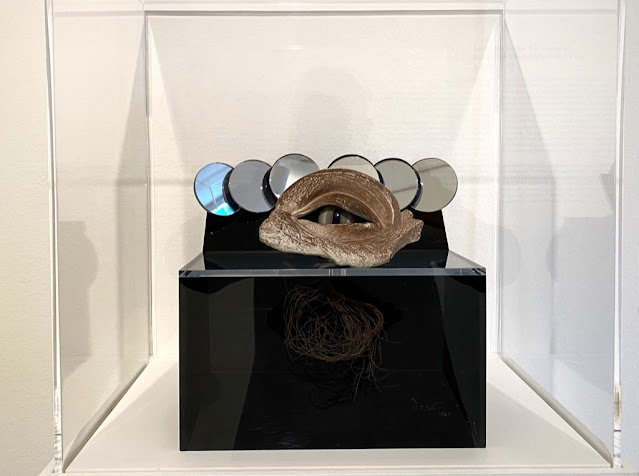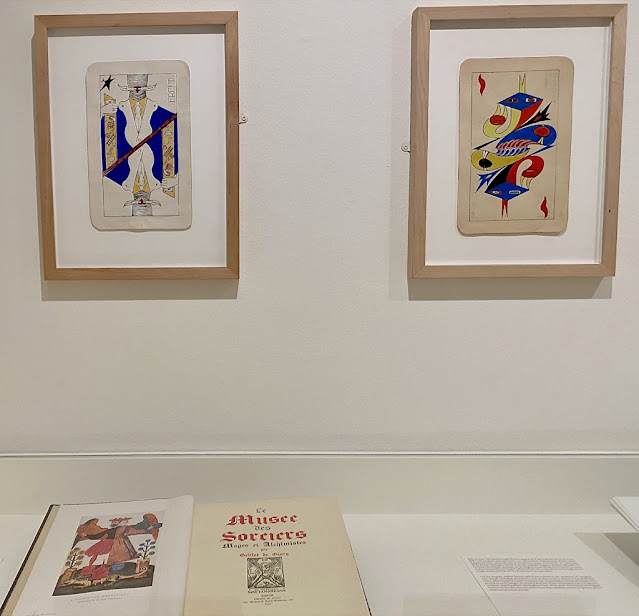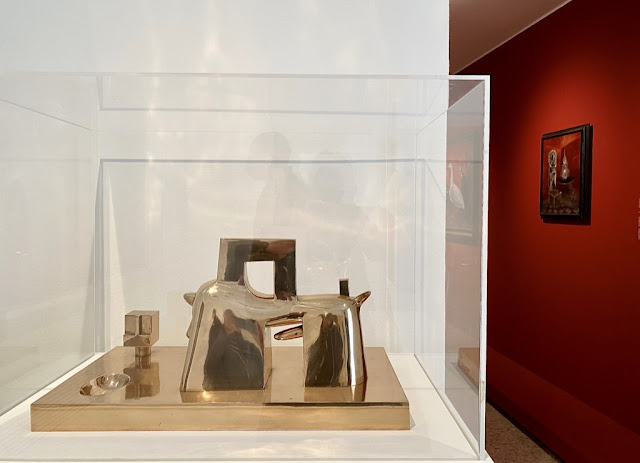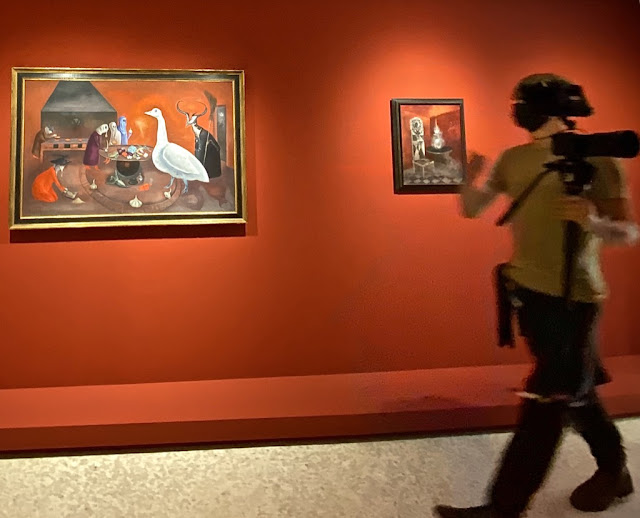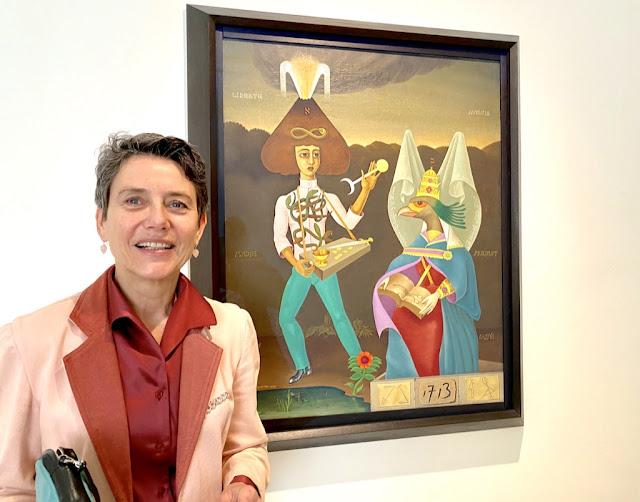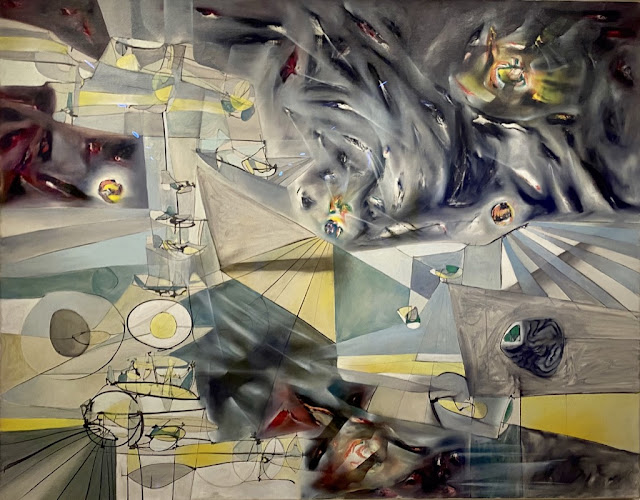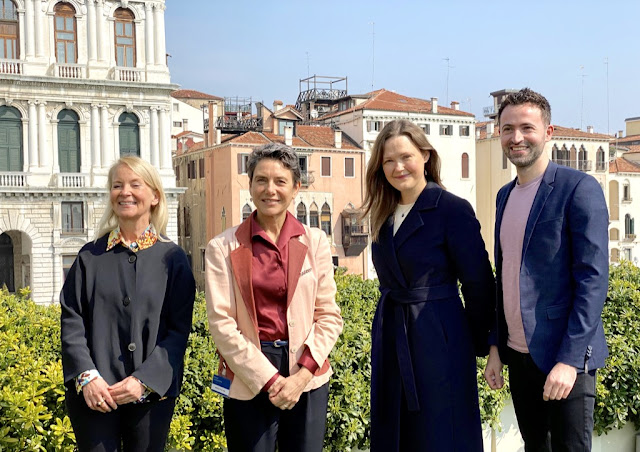"(Magic is) the means of approaching the unknown
by other ways than those of science or religion."
Max Ernst
Max Ernst
1946
Peggy Guggenheim Collection
Surrealism and Magic: Enchanted Modernity
Surrealism and Magic: Enchanted Modernity is a joint exhibition project between the Peggy Guggenheim Collection - until September 26 - and the Museum Barberini in Potsdam from October 22nd - curated by Grazina Subelyte. It is the first large-scale international loan exhibition that looks at the movement’s interest in magic and the occult. Presenting about 60 works, in the Venetian venue, from over 40 international museums and private collections, it offers a rich overview of the entire development of the Surrealist movement, exploring the myriad ways, in which magic and the occult informed its artistic trajectory, from the - “metaphysical painting” - Giorgio de Chirico around 1915 - through Max Ernst’s iconic painting - Attirement of the Bride - 1940 - to the occult imagery that underpinned the late works of Leonora Carrington and Remedios Varo. In their works, Surrealist artists frequently drew on occult symbolism and cultivated the traditional image of the artist’s persona as a magician, seer, and alchemist, looking to magic as a poetic and deeply philosophical discourse, related to individual self-empowerment.
"The artists created bizarre dreamscapes that could be described as occult topographies or cosmic fantasies."
Enrico Donati - The Evil Eye - 1946
The exhibition’s point of departure is the world-class Surrealist holdings of the Peggy Guggenheim Collection, containing iconic paintings that powerfully reflect the Surrealists’ dialogue with the occult tradition. Many of the artists represented in this show were exhibited during their lifetimes by Peggy Guggenheim, who emerged as one of the most energetic collectors and patrons of Surrealism toward the end of the 1930s. Having familiarized herself with the movement during her stay in Paris between the wars, she was on intimate terms with Max Ernst and Andre Breton, founder of Surrealism with his Manifesto of Surrealism, published in October 1924.
Max Ernst - Attirement of the Bride - 1940
Reunited after 80
years, these two masterpieces; Ernst’s Attirement of the Bride and Carrington’s Portrait of
Max Ernst - 1939c; in his painting, Ernst depicts Carrington as a witch
and an enchantress, while Carrington portrays Ernst as an alchemist a hermit a
shamanic figure. This highlights their artistic exchange and shared interests
in witchcraft, magic, and alchemical and animal symbolism. Also, it reveals
Carrington’s influence on Ernst, since her portrait likely acted as a key
inspiration for Ernst.
Leonora Carrington - Portrait of Max Ernst - 1939c.
Oscar Dominguez - 1906-1957 - Freud - Magus of Dreams-Star
Jacqueline Lamba - 1910-1993 - Baudelaire - Genius of Love-Flame
Andre Masson - Study for the Portrait of Goethe - 1940
The exhibition explores themes such as alchemy, metamorphosis and
the androgyne, the tarot, the evil eye, totemic substance, invisible and cosmic
dimensions, as well as the notion of the artist as a magician and woman as a
magical being, goddess, and witch. It begins with the - metaphysical
paintings - of Giorgio de Chirico, whom Breton considered the chief precursor of
the Surrealist movement, and confirmed his influence on their early fascination
with magic and the occult. De Chirico’s seminal painting The Child’s Brain - 1914 - which was
part of Breton’s personal collection at home, is on view.
Giorgio de Chirico - The Child's Brain - 1914
Grazina Subelyte
Curator of the Exhibition and Associate curator - Peggy Guggenheim Collection
Max Ernst - The King Playing with the Queen - 1944
The
Swiss-born artist and occult scholar Kurt Seligmann painted works infused with magical undercurrents and wrote
the book The Mirror of Magic - 1948 - now an occult classic, widely read
by the Surrealists, Carrington among them.
Kurt Seligmann - Baphomet - 1948
The Surrealist conception of women was multifaceted, even contradictory: they were deadly, disorderly, erotic, magical, powerful. Women in surrealist imagery could transform, or be transformed, into fairies, goddesses, priestesses, prophetesses, witches or dangerous mythical beasts, including chimeras, sirens, and sphinxes.
Dorothea Tanning - The Magic Flower Game - 1941
Male painters Paul Delvaux, Rene Magritte, and Andre Masson, assigned women stereotypical attributes in their works - sexualized, fertile, bound to nature. Nonetheless, in theory male Surrealists championed women.
Paul Delvaux The Call of the Night - 1938
Rene Magritte - Black Magic - La Magie Noir - 1945
In Sphinx - 1947 - Freddie reinterpreted the tibular hybrid androgynous creature of ancient mythology, a recurrent motif in his production. For him the sphinx symbolized - a woman with an animal's body, here with a distinctly masculine character - emphasized by a prominent phallus. Embodying the - enigma of life and death - at once seductive and violent, in this sculpture the inscrutable sphinx also signifies estrangement. Freddie's erotic subjects and iconoclastic behavior made him a scandalous figure in his time.
Wilhelm Freddie - Sphinx - 1947
From the late 1930s, the English-born artist Leonora Carrington was a central player in Surrealism. Although her partnership with Max Ernst in 1937-40 fueled her fascination with magic, her study of its history and symbolism predated her association with Surrealism, and she appropriated the movement's ideas in a very personal way. Of Anglo-Irish heritage, she identified with Celtic folklore and adopted the witch and enchantress as formidable alter egos. Subverting the stereotypical vision of the sexualized and deviant enchantress, Carrington transformed her into an icon of female empowerment.
Leonora Carrington - Grandmother Moorhead's Aromatic Kitchen - 1975
Leonora Carrington - The Necromancer - 1950c.
These scenes correspond to the four elements of medieval alchemy, namely, air, earth, water, and fire, and reference rituals of destruction and rebirth. The subject was the promiscuous Dagobert, the last Frankish King of the Merovingian dynasty, who ruled Gaul in the seventh century. According to legend, the royal line of the Merovingians had supernatural origins and before their conversion to Christianity they were pagan priest-monarchs. Carrington fused this legend and the alchemical and fantastical setting, creating an alternative cosmos with divine female characters who encircle what might be a mocking portrayal of an elderly Dagobert in a red robe being pulled on a cart by a child.
Leonora Carrington - The Pleasures of Dagobert - 1945
Remedios Varo - The Watchmaker or Revelation - 1955
Leonor Fini and Remedios Varo deployed magical and mythological thematics in their work to very different ends from their male Surrealist counterparts. Unlike the majority of the men in the circle around Andre Breton, Fini and Varos rejected representations of subjugated women, such as the clairvoyant or the muse, instead, they critically investigated the possibility of emancipated female subjects offered by the realm of enchantment.
Leonor Fini - Portrait of the Princess Francesca Ruspoli - 1944
Fist by Enrico Donati, consists of a hand clenching two fishy eyes which together create an uncanny facial expression. The work alludes to the evil eye. In Le Surrealisme exhibition at the Galerie Maeght in Paris in 1947, it was dedicated to superstition, where the viewers were meant to conceptually confront and ward off their fears.
Enrico Donati - Fist - 1946-1997
Magic,
the tarot, and the Kabbalah were central to the art of Romanian-born Jewish
artist Victor Brauner. While titling the work after the sixth card of the Major Arcana in the
traditional tarot deck, Brauner’s “lovers” allude to the male and female figures
pictured on “The Magician” and “The Priestess” cards. Both have magical
associations and their meeting in the painting represents the alchemical “Royal
Wedding,” or the ideal union of the sexes.
Karole P. B. Vail - director of the Peggy Guggenheim Collection
Victor Bauner - The Lovers - 1947
Despite
their absorption in magic and the occult, the Surrealists reconsidered the idea
of the supernatural, which refers to phenomena beyond the tangible universe. They arrived at the notion of the “surreal,” locating such experiences
in concealed layers of the lived world. They used the term “marvelous” almost
interchangeably with surreal.
The
artists created bizarre dreamscapes that could be described as occult
topographies or cosmic fantasies.
Roberto Matta - Years of Fear - 1941
Kay Sage - Tomorrow is Never - 1955
Dali's floating, often biomorphic, shapes invoke a nightmarish world in direct response to the United States' nuclear attack on the Japanese cities of Hiroshima and Nagasaki.
Salvador Dali - Uranium and Atomica Melancholica Idyll - 1945
"The artists created bizarre dreamscapes that could be described as occult topographies or cosmic fantasies."
Andre Breton
Second Manifesto of Surrealism - 1929
Yves Tanguy - Fear - 1949
The Press Preview
Ortrud Westheider - Director Museum Barberini, Potsdam - Karole P. B. Vail - Director Peggy Guggenheim Collection - Grazina Subelyte - Associated Curator Peggy Guggenheim Collection - Daniel Zamani - Curator Museum Barberini Potsdam
Rosemary and Kevin McNeely
Vivien Greene and Luciano Pensabene Buemi
Dorothea Tanning and Max Ernst
Leonora Carrington and Leonor Fini
